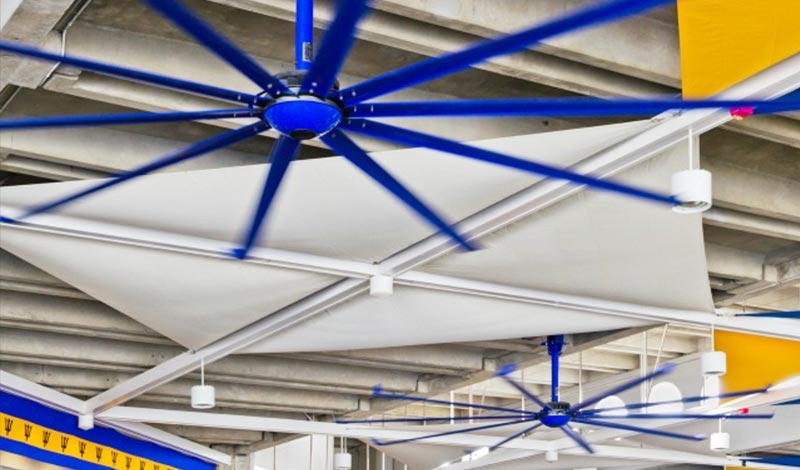Warm air rises. That can be a problem in high-bay spaces where a ceiling-down approach is used for heating and cooling. The air temperature near the ceiling can be 10°F to 30°F higher than in the occupied zone. Using fans to destratify (mix) this air can significantly reduce space conditioning costs and improve building comfort.
Deconstructing destratification
How does air destratification work? Destratification fans create a circular column of turbulent air. The highest velocities are found at the air column’s outer wall. As the high velocity air nears floor level, the velocity kinetic energy is converted into static pressure that rapidly expands air outward. This airflow mixes the air between the fan and the floor. The moving air warms occupants in winter and cools them in the winter.

The right mix
Two technologies are available for air destratification — high-volume low-speed (HVLS) fans and air turbines.
Small, high-velocity fans create small diameter turbulent air streams which dissipate quickly. By comparison, a high-volume low-speed (HVLS) fan moves a large volume of air very slowly. A study by Southern Polytechnic State University found that large diameter fans can provide energy savings of 40% compared to conventional fans while providing the same airflow at floor level.
Air turbines use stator vanes and Venturi nozzles to create columnar laminar (non-turbulent) air flows. This results in higher air velocity, longer throw distances and improved air circulation patterns. Manufacturers of these types of fans claim that they also better entrain surrounding air into the air column, resulting in better mixing. They’re also more compact and lightweight than HVLS fans with less visual disruption.
Cash flow
What are the potential savings? Let’s examine a 30,000 square foot warehouse with two 24-foot fans installed at a cost of $11,500. Each fan operates nine hours a day and has a one horsepower (1 HP) motor that draws 830 watts of power during operation. Fan energy consumption is calculated to be 1,630 kWh per season.
Fan energy = Power (kW) x Time (hours) = 2 x 0.83 kW x 1,000 hours = 1,630 kWh = $140 @$0.085/kWh
The total winter heating cost at the facility is $10,000. Assuming a 30% reduction ($3,000) in heating costs and an electric rate of $0.085/kWh, the cost savings would be $2,860 per year ($3,000 – $140). Cooling savings in the summer would create some additional annual savings.
Fan performance is measured using cubic feet per minute (CFM) of airflow. A good way to compare fan efficiency is to divide a fan’s CFM output with its wattage input (CFM/watt). Anything over 400 CFM per watt is considered efficient. Also, 6-blade HVLS fans provide more airflow compared to 10-blade fans.
Drawbacks
Air destratification devices do have their issues. Seventhwave identified a number of potential drawbacks:
- Acoustical concerns (less in manufacturing environments).
- Lack of understanding among building designers, owners and operators.
- Installation constraints.
- Activity in the space (gymnasium) may cause damage to fans.
- Strobe effect if fans are installed directly below lights.
- Facility staff must be educated in proper use of fans.
- Potential for drafts if fan speed is too high (air speed at occupant heat height should be less than 50 feet per minute).
Despite these barriers, consider destratification devices to reduce heating and cooling costs in high-bay spaces.
